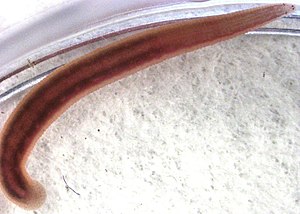Salifidae
| Salifidae | ||||||||||||
|---|---|---|---|---|---|---|---|---|---|---|---|---|

|
||||||||||||
| Systematics | ||||||||||||
|
||||||||||||
| Scientific name | ||||||||||||
| Salifidae | ||||||||||||
| Johansson , 1910 |
Salifidae is the name of a family of predatory live leeches in the order of Schlundegel with partly fresh water , some terrestrial species , in Africa and Asia are common.
features
The small to very large flukes of the Salifidae family usually have a cylindrical body shape reminiscent of earthworms. The leeches have 5 to 8 pairs of eyes, including one labial main pair of eyes. The genus Barbronia, which is usually included in this family (otherwise separate family), on the other hand, has species with 3 pairs of eyes. Of the externally not recognizable segments, as in the case of the roller gels 16 (in the case of Barbronia 17), segments each comprise five outer ringlets. The large, muscular pharynx has three pairs of needle-shaped stilettos sitting on three muscular ridges or "false jaws" (pseudognatha). In adaptation to the predatory way of life, the intestinal canal does not have the blind sacs known from blood-sucking leech groups. The hermaphroditic members of this family, like all leeches, have a few large, blister-shaped testicles in the testicle-bearing segments , in which they differ from the roller gel.
Distribution, habitat and way of life
The leeches are inhabitants of fresh water or of the ground on land, where they predatory feed on small animals. The prey - often externally very similar annelworms such as earthworms or mud tubeworms , but also insect larvae - is swallowed whole with the help of the muscular pharynx.
While the approximately 7 species of the genus Salifa living in freshwater are common in Africa , South Asia and East Asia , the limnic representatives of the genus Barbronia live in Asia from Afghanistan to Java and in southern China . Barbronia weberi has been introduced by humans to North America , South America and Europe ( Italy ), where it is spreading as an invasive species . The leeches of the genus Mimobdella , on the other hand, are rural and widespread from Southeast Asia to Japan ( Mimobdella japonica ). This genus is possibly the largest species of the family, the Mimobdella buettikoferi , native to Mount Kinabalu in the Malaysian part of Borneo , which also devours very large giant earthworms .
Reproductive cycle
Like all leeches, the Salifidae are hermaphrodites that mate as throat leeches through mutual injection of pseudopermatophores ( hypodermic insemination ). The clitellum forms an egg cocoon made of mucus in which the mother lays the fertilized eggs. Developed little leeches hatch from these.
Systematics
The following genera belong to the Salifidae family :
In 1996 El-Shimy put the genus Barbronia , whose representatives only have 3 pairs of eyes and 17 segments each have 5 outer ringlets, in a separate family Barbroniidae.
literature
- Hasko Friedrich Nesemann: Aquatic invertebrates of the Ganga River System: Mollusca, Annelida, Crustacea (in part) , Volume 1. Chandi Press, Kathmandu 2007. p. 189, Salifidae Johansson, 1910 .
- Roy T. Sawyer: Leech Biology and Behavior. Clarendon Press. Oxford 1986. p. 695, Family: Salifidae Johansson, 1910 .
- Nasser A. El-Shimy, 1996. Revision of the genus Barbronia Johansson, 1918 (Hirudinea: Erpobdellifonnes: Barbronidae) in Egypt. Zoology in the Middle East 12, pp. 99-104, here p. 100, Family Barbronidae Johansson, 1918 .